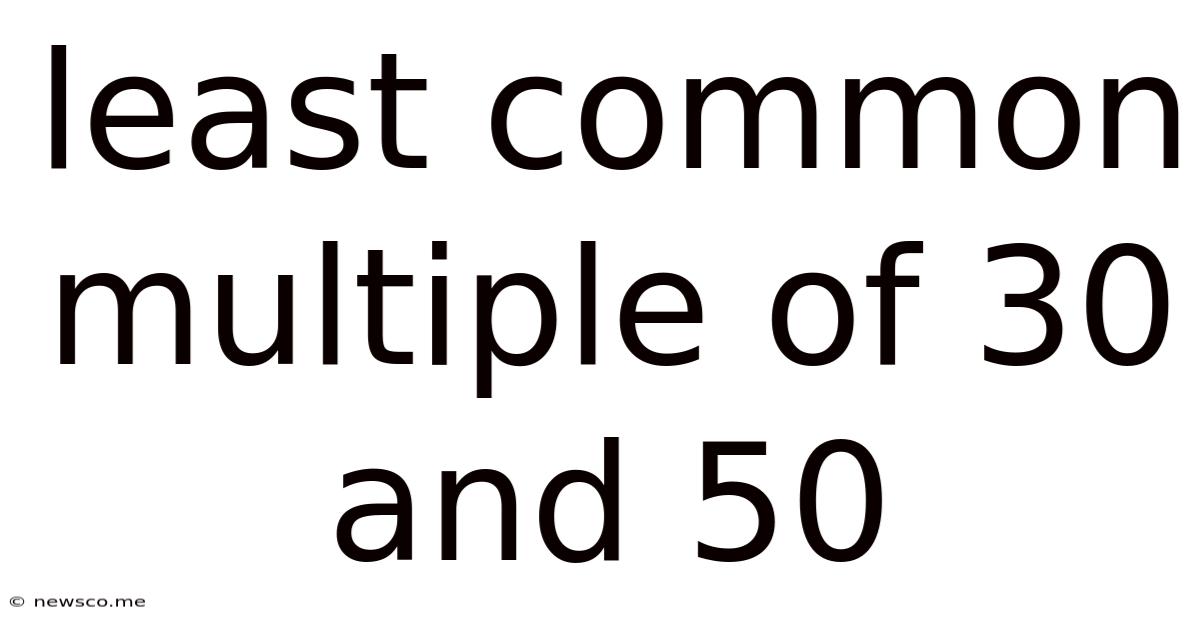Least Common Multiple Of 30 And 50
News Co
Mar 31, 2025 · 5 min read

Table of Contents
Finding the Least Common Multiple (LCM) of 30 and 50: A Comprehensive Guide
Finding the least common multiple (LCM) is a fundamental concept in arithmetic and number theory with applications spanning various fields, from scheduling to music theory. This article delves deep into calculating the LCM of 30 and 50, exploring multiple methods and providing a comprehensive understanding of the underlying principles. We'll also touch upon the practical uses of LCM calculations and how to approach more complex scenarios.
Understanding Least Common Multiples
Before diving into the calculation, let's define what a least common multiple is. The LCM of two or more integers is the smallest positive integer that is divisible by all the integers. In simpler terms, it's the smallest number that contains all the numbers as factors.
For example, consider the numbers 2 and 3. Their multiples are:
- Multiples of 2: 2, 4, 6, 8, 10, 12, 14, 16...
- Multiples of 3: 3, 6, 9, 12, 15, 18...
The common multiples are 6, 12, 18... and the least common multiple is 6.
Method 1: Listing Multiples
The most straightforward, albeit sometimes tedious, method for finding the LCM is by listing the multiples of each number until a common multiple is found.
Let's apply this to 30 and 50:
- Multiples of 30: 30, 60, 90, 120, 150, 180, 210, 240, 270, 300...
- Multiples of 50: 50, 100, 150, 200, 250, 300...
By comparing the lists, we can see that the smallest common multiple is 150. Therefore, the LCM(30, 50) = 150. This method works well for smaller numbers but becomes impractical for larger numbers.
Method 2: Prime Factorization
A more efficient and elegant method involves prime factorization. This method breaks down each number into its prime factors – numbers that are only divisible by 1 and themselves.
-
Prime Factorization of 30:
30 = 2 x 3 x 5
-
Prime Factorization of 50:
50 = 2 x 5 x 5 = 2 x 5²
-
Finding the LCM:
To find the LCM using prime factorization, we take the highest power of each prime factor present in either factorization and multiply them together.
- The prime factors are 2, 3, and 5.
- The highest power of 2 is 2¹ (from 30).
- The highest power of 3 is 3¹ (from 30).
- The highest power of 5 is 5² (from 50).
Therefore, LCM(30, 50) = 2¹ x 3¹ x 5² = 2 x 3 x 25 = 150.
Method 3: Using the Greatest Common Divisor (GCD)
The LCM and the greatest common divisor (GCD) are closely related. The product of the LCM and GCD of two numbers is equal to the product of the two numbers. This means:
LCM(a, b) x GCD(a, b) = a x b
We can use this relationship to find the LCM if we know the GCD. Let's find the GCD of 30 and 50 using the Euclidean algorithm:
- Divide the larger number (50) by the smaller number (30): 50 ÷ 30 = 1 with a remainder of 20.
- Replace the larger number with the remainder (20) and repeat: 30 ÷ 20 = 1 with a remainder of 10.
- Repeat: 20 ÷ 10 = 2 with a remainder of 0.
- The last non-zero remainder is the GCD, which is 10.
Now, we can use the formula:
LCM(30, 50) = (30 x 50) / GCD(30, 50) = (30 x 50) / 10 = 150
Comparing the Methods
All three methods yield the same result: the LCM of 30 and 50 is 150. The prime factorization method is generally the most efficient for larger numbers, while the listing multiples method is best for small numbers where you can easily visualize the multiples. The GCD method provides a powerful connection between LCM and GCD, and the Euclidean algorithm is highly efficient for finding the GCD.
Real-World Applications of LCM
The concept of LCM finds practical applications in various scenarios:
-
Scheduling: Imagine two buses depart from a station at different intervals. The LCM helps determine when they'll depart together again. For instance, if one bus departs every 30 minutes and another every 50 minutes, they'll depart simultaneously again after 150 minutes (2.5 hours).
-
Music: In music theory, LCM is used to determine the least common denominator for rhythmic patterns, helping composers understand and synchronize different musical phrases.
-
Construction and Engineering: LCM helps in aligning repetitive patterns in construction, ensuring proper spacing and synchronization of various components.
-
Computer Science: LCM calculations are used in algorithms related to scheduling, synchronization, and data management.
Extending to More Than Two Numbers
The methods described above can be extended to find the LCM of more than two numbers. For prime factorization, you simply consider all prime factors from all numbers and take the highest power of each. For the GCD method, you can iteratively find the GCD of pairs of numbers and then use the formula to find the overall LCM.
Conclusion: Mastering LCM Calculations
Understanding and mastering the calculation of least common multiples is a valuable skill with broad applications. While listing multiples is a simple approach for smaller numbers, prime factorization and the GCD method provide more efficient and scalable solutions for larger and more complex scenarios. Choosing the right method depends on the specific problem and the numbers involved. By understanding the underlying principles and the various techniques, you'll be equipped to tackle LCM calculations with confidence and efficiency. Remember to practice with different examples to solidify your understanding and build your problem-solving skills.
Latest Posts
Related Post
Thank you for visiting our website which covers about Least Common Multiple Of 30 And 50 . We hope the information provided has been useful to you. Feel free to contact us if you have any questions or need further assistance. See you next time and don't miss to bookmark.